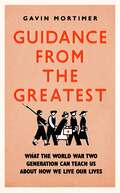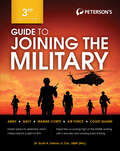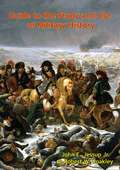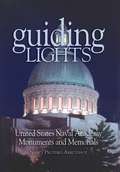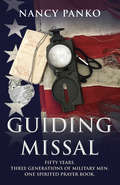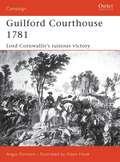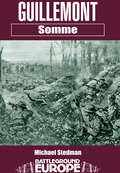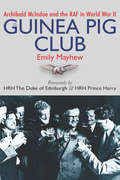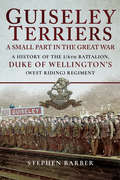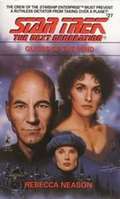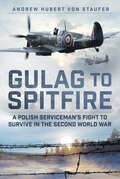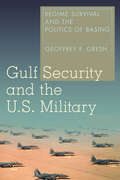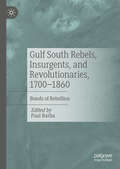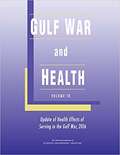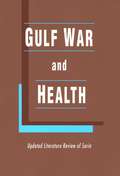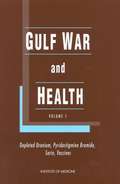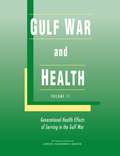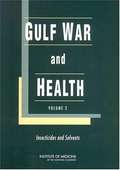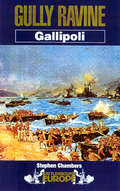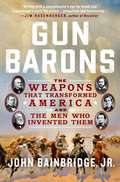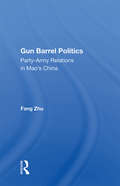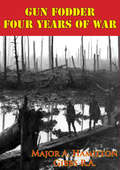- Table View
- List View
Guidance from the Greatest: What the World War Two generation can teach us about how we live our lives
by Gavin Mortimer'We will overcome it [and] I hope in the years to come, everyone will be able to take pride in how they responded to this challenge, and those who come after us will say the Britons of this generation were as strong as any' Her Majesty The QueenThe Coronavirus pandemic forced the great British people to dig to the very depths of their resolve. It was during this crisis, the gravest crisis the country has faced since the Second World War, that members of the Greatest Generation - Tom Moore, Dame Vera Lynn, the Queen - proved vital reminders of the self-effacing stoicism required in times of emergency; to summon our 'Blitz spirit' and to 'Keep Calm and Carry On'.Taking twelve qualities of the wartime generation, including fellowship, courage and integrity, and drawing on personal interviews with over two hundred Second World War veterans - from SAS officers to London firewomen to Dame Vera herself - Guidance from the Greatest shows us how we can improve our individual character and our collective approach to life.Guidance from the Greatest reminds us of all that is great about Britain and shows how we can build upon that greatness for the future.
Guidance from the Greatest: What the World War Two generation can teach us about how we live our lives
by Gavin Mortimer'We will overcome it [and] I hope in the years to come, everyone will be able to take pride in how they responded to this challenge, and those who come after us will say the Britons of this generation were as strong as any' Her Majesty The QueenThe Coronavirus pandemic forced the great British people to dig to the very depths of their resolve. It was during this crisis, the gravest crisis the country has faced since the Second World War, that members of the Greatest Generation - Tom Moore, Dame Vera Lynn, the Queen - proved vital reminders of the self-effacing stoicism required in times of emergency; to summon our 'Blitz spirit' and to 'Keep Calm and Carry On'.Taking twelve qualities of the wartime generation, including fellowship, courage and integrity, and drawing on personal interviews with over two hundred Second World War veterans - from SAS officers to London firewomen to Dame Vera herself - Guidance from the Greatest shows us how we can improve our individual character and our collective approach to life.Guidance from the Greatest reminds us of all that is great about Britain and shows how we can build upon that greatness for the future.
Guide to Joining the Military
by Peterson'sGuide to Joining the Military includes topics like: women in the military, details on opportunities available within all branches of the military, what to expect from a military career, information on joining the national guard and reserve, coverage of the ASVAB examination, details on the physical exam and background investigation, basic training facts (daily schedules, training regimens, physical conditioning and more).
Guide to the Study and Use of Military History
by Robert W. Coakley John E. Jessup Jr.A collection of essays that discuss for the military student and others the nature of history, the importance of military history, and the applied study of military history. The volume includes bibliographical essays on military history, descriptive accounts of the historical organization of the U.S. Army and other parts of the Defense establishment, and discussions of the study of military history in foreign armies and in the academic world.OVER the years the study of military history has had its ups and downs within the Army. In the education of the World War II generation of military leaders it played an important part, for the study of past operations held a preeminent place in the Army schools curricula in the period between the two great world wars. In the years immediately following World War II it lost that place. This happened partly because the information explosion broadened so greatly the areas in which an officer had to be knowledgeable and partly because of a belief that the pace of change in technology had rendered the study of past experience irrelevant. In the Army’s higher schools, military history became largely a matter of using examples from the past in courses dealing with current problems.
Guidebook to the Historic Sites of the War of 1812: 2nd Edition, Revised and Updated
by Gilbert CollinsThere have been guidebooks to military sites before, but no other book has covered the War of 1812 in its entirety. This well-illustrated updated edition covers more than 400 historic sites of the War of 1812, both well-known and obscure, in both Canada and the United States.The author has used old pen and ink drawings from the last century to give a "then and now" feel to the book. Curious to know what is at the site of the Battle of Queenston Heights? Besides giving readers a detailed history of the events that occurred at the sites, the author describes what they have to offer visitors today, be it a historical plaque, historic house, or major interpretive centre.This book is a handy tool for both travellers and historians. It remains the only book on the market offering a comprehensive guide to nearly all of the sites in our last war with the United States.
Guiding Lights
by Nancy ArbuthnotIn this easy-to-use reference, Naval Academy English professor Nancy Prothro Arbuthnot tells the stories behind sixty of the Academy's monuments and memorials. To personalize the memorials and the naval figures they honor, she has included letters, firsthand battle reports, Lucky Bag commentaries, award citations, and other documents. Along with famous quotations, the book also presents poems and tributes written by midshipmen that explain how the memorials have inspired them, along with original poems by the author. More than 140 illustrations, including black-and-white photographs and reproductions of historic sketches, visually enrich the book. In revealing the people and events behind the Academy s memorials, Arbuthnot provides models or guiding lights to help readers steer their own courses through life.
Guiding Missal: Fifty Years. Three Generations of Military Men. One Spirited Prayer Book.
by Nancy PankoIn 1944, a U.S. Army baker volunteers as a forward observer to carry out covert operations behind German lines in World War II. In the early 1960s, a focused nineteen-year-old Airman is responsible for decoding critical top secret messages during the height of the Berlin Crisis. In 1993, an army sniper overcomes a debilitating condition only to fight for survival in the streets of war-torn Mogadishu, Somalia, when a Blackhawk helicopter is shot down. When each of these men face a crisis, this very special prayer book, My Military Missal, provides the comfort and encouragement of divine power. Based on actual events, Guiding Missal’s timeless journey of faith, patriotism and miracles will touch your heart as the missal and the men call out to God for guidance, protection, and a safe return home.
Guilford Courthouse 1781
by Adam Hook Angus KonstamBy the Spring of 1781, the American Revolutionary War (1775-1783) had dragged on for almost six years and the outcome still hung in the balance. When the British commander Lord Cornwallis launched his invasion of North Carolina in early 1781, his objective was to destroy General Nathaniel Greene's American army. At Guilford Courthouse on 15 March 1781 the two armies met. In a desperately hard-fought battle the small but professional British army succeeded in fighting its way through three separate lines of American troops - but at a dreadful cost. Cornwallis lost over a quarter of his command. When news of the 'victory' reached Britain, a politician remarked; 'Another such victory would ruin the British army'.
Guillemont: Somme (Battleground Europe)
by Michael StedmanThe battle for Guillemont raged throughout August 1916. Like so many of the battles into which the 'Big Push' degenerated, the struggle centred around a wood, Trones, and a heavily fortified village. It was in this battle that Noel Chavasse won the first of his two Vcs.
Guinea Pig Club: Archibald McIndoe and the RAF in World War II
by Emily Mayhew'This book speaks to two of the most diametrically opposed yet mutually supportive aspects of war: the ability to inflict horrific injury and the ability to heal Mayhew is to be commended on an outstanding addition to expanding our knowledge of an area rarely discussed by historians. Her book should be mandatory reading for all defence members (both civilian and military) and on everyone's history shelf. This book is highly recommended.' Airforce MagazineThe history of the Guinea Pig Club, the band of airmen who were seriously burned in aeroplane fires, is a truly inspiring, spine-tingling tale.Plastic surgery was in its infancy before the Second World War. The most rudimentary techniques were only known to a few surgeons worldwide. The Allies were tremendously fortunate in having the maverick surgeon Archibald McIndoe nicknamed the Boss or the Maestro operating at a small hospital in East Grinstead in the south of England. McIndoe constructed a medical infrastructure from scratch.After arguing with his superiors, he set up a revolutionary new treatment regime. Uniquely concerned with the social environment, or holistic care , McIndoe also enlisted the help of the local civilian population. He rightly secured his group of patients dubbed the Guinea Pig Club an honoured place in society as heroes of Britain s war. For the first time official records have been used to explain fully how and why this remarkable relationship developed between the Guinea Pig Club, the RAF and the Home Front.First-person recollections bring to life the heroism of the airmen with incredible clarity.This is a revised and expanded edition with new material, including a foreword by HRH Prince Harry, published to tie in with a major new film expected to be released in late 2018.
Guiseley Terriers: A History of the 1/6th Battalion, Duke of Wellington's (West Riding) Regiment
by Stephen BarberAfter the Battle of the Lys in April 1918, Field-Marshal Sir Douglas Haig said of the 147th (Territorial) Brigade:'I desire to express my appreciation of the very valuable and gallant services performed by troops of the 49th (West Riding) Division since the entry of the 147th Brigade into the Battle of Armentires. The courage and determination showed by this division has played no small part in checking the enemys advance and I wish to convey to General Cameron and all the officers and men under his command my thanks for all they have done.'In April 1918, the Saturday night soldiers from Bingley, Guiseley, Haworth, Keighley, Settle and Skipton halted the German advance at a critical time in the war during the German spring offensive. Haigs Backs to the Wall order had just been issued when the 1/6th Duke of Wellingtons Regiment was sent to the front-line at Armentires. After nearly four years at the front, they had been transformed from part-time enthusiastic amateurs to battle hardened veterans, having fought in some of the Great War's major battles, including suffering the effects of mustard gas at Nieuport. It was a source of pride to the men of the battalion that they had never given up ground to the enemy, unless ordered to by a higher authority, and only then reluctantly.Using newspaper archives, war diary extracts, personal accounts and previously unpublished photographs, Stephen Barber retraces the formation and history of the 1/6th Duke of Wellingtons Regiment from the creation of the Volunteer Rifle Corps in 1860, to its mobilisation in the Great War. A day-by-day account of their movements and actions over the four-year period culminates in the pursuit of the retreating German Army at Famars, on 1 November 1918.
Guises of the Mind
by Rebecca NeasonThe world Capulon IV is finally ready to join the Federation aften years of waiting. All that remains is the ruler's coronation and a routine signing of the final treaty. When the crew of the U.S.S. Enterprise and their passengers -- a group of women from a religious order dedicated to helping the downtrodden -- arrive for the event they expect to find a world willing and happy to receicve them. Instead, they encounter deceit and treachery. The crown prince, once excited and eager to join the Federation, now refuses even to speak with Captain Picard. Beaming to the surface in an attempt to work out the problem, Picard, Troi, and Mother Veronica, the abbess of the nuns, are drugged and captured. Now they must somehow excape and stop the crowning. If they cannot prevent it, the King will be omnipotent, with the power to destroy the Starship Enterprise and all of Capulon IV as well...
Gulag to Spitfire: A Polish Serviceman's Fight to Survive in the Second World War
by Andrew Hubert von StauferStalin is quoted as saying 'One man's death is a tragedy, a thousand deaths is a statistic'. This is the story of a man who was determined to be neither. Kazimierz Tomasz 'Tomek' Hubert was 17 when the Germans invaded Poland in September 1939. Despite his young age, he was quickly deported to the Vorkuta Gulag in the Arctic Circle, for the crime of being the son of a military governor. Here he would survive torture, starvation and even the threat of cannibalism, before he managed to escape and set off on a 6,000km walk to freedom. In this moving tale of endurance against all odds, Andrew Hubert von Staufer traces his father's footsteps from the gulags of Siberia to flying Spitfires in air battles against the Luftwaffe. This is a remarkable account of the Second World War and its long-reaching impact.
Gulf Security and the U.S. Military: Regime Survival and the Politics of Basing
by Geoffrey F. GreshThe U. S. military maintains a significant presence across the Arabian Peninsula but it must now confront a new and emerging dynamic as most Gulf Cooperation Council countries have begun to diversify their political, economic, and security partnerships with countries other than the United States--with many turning to ascending powers such as China, Russia, and India. For Gulf Arab monarchies, the choice of security partner is made more complicated by increased domestic and regional instability stemming in part from Iraq, Syria, and a menacing Iran: factors that threaten to alter totally the Gulf's current security dynamic. Understanding the dynamics of base politicization in a Gulf host nation--or any other--is therefore vitally important for the U. S. today. Gulf National Security and the U. S. Military examines both Gulf Arab national security and U. S. military basing relations with Gulf Arab monarchy hosts from the Second World War to the present day. Three in-depth country cases--Saudi Arabia, Bahrain, and Oman--help explain the important questions posed by the author regarding when and why a host nation either terminated a U. S. military basing presence or granted U. S. military basing access. The analysis of the cases offers a fresh perspective on how the United States has adapted to sometimes rapidly shifting regional security dynamics and factors that influence a host nation's preference for eviction or renegotiation, based on its perception of internal versus external threats.
Gulf South Rebels, Insurgents, and Revolutionaries, 1700-1860: Bonds of Rebellion
by Paul BarbaGulf South Rebels, Insurgents, and Revolutionaries is a collection of essays on the tangled yet variegated histories of rebellious actors in the eighteenth- and nineteenth-century Gulf South and its linked environs. Following diverse rebels, revolutionaries, militants, insurgents, opportunists, and subversives from the early eighteenth-century alluvial floodplains of Louisiana to the mid-nineteenth-century coastal prairies of southeast Texas, this volume recasts the Gulf South as a centripetal region in the history of early America, a place where worlds collided, overlapped, combined, and renewed themselves, where revolutionary fervor could thrive and percolate, mix, and coagulate. Bound together by violence, exploitation, greed, honor, family, community, and ideological commitment, Gulf South rebels drew from longer traditions of insurgency, even as they forged new ones. Their legacies would resonate well beyond their seemingly localized disturbances, from the Caribbean to western Europe, illuminating how Indigenous, Black, and Euro-American Gulf South rebels operated in a rapidly shrinking, colonial world.
Gulf War and Health
by Committee on Gulf War Health: Treatment for Chronic Multisymptom IllnessInfectious diseases have been a problem for military personnel throughout history. The consequences in previous conflicts have ranged from frequent illnesses disrupting daily activities and readiness to widespread deaths. Preventive measures, early diagnosis, and treatment greatly limit the exposures and acute illnesses of troops today in comparison with those in armies of the past, but infections and consequent acute illnesses still occur. Thousands of US veterans of the Persian Gulf War have reported an array of unexplained illnesses since the war ended in 1991. Many veterans have believed that the illnesses were associated with their military service in southwest Asia during the war. This volume of Gulf War and Health evaluates the scientific literature on chemical, biologic, and physical agents to which military personnel in the gulf were potentially exposed and possible long-term adverse health outcomes.
Gulf War and Health: Update of Health Effects of Serving in the Gulf War, 2016
by Engineering Medicine National Academies of SciencesFor the United States, the 1991 Persian Gulf War was a brief and successful military operation with few injuries and deaths. However, soon after returning from duty, a large number of veterans began reporting health problems they believed were associated with their service in the Gulf. At the request of Congress, the Institute of Medicine (IOM) has been conducting an ongoing review of the evidence to determine veterans' long-term health problems and potential causes. The fourth volume in the series, released in 2006, summarizes the long-term health problems seen in Gulf War veterans. In 2010, the IOM released an update that focuses on existing health problems and identifies possible new ones, considering evidence collected since the initial summary. Gulf War and Health: Volume 10, the final volume of the series, is an update of the scientific and medical literature on the health effects associated with deployment to the Gulf War that were identified in Volumes 4 and 8. This report reviews and evaluates the associations between illness and exposure to toxic agents, environmental or wartime hazards, or preventive measures and vaccines associated with Gulf War service, and provides recommendations for future research efforts on Gulf War veterans.
Gulf War and Health: Updated Literature Review of Sarin
by Committee on Gulf WarThe Gulf War in 1990-1991 was considered a brief and successful military operation, with few injuries or deaths of US troops. The war began in August 1990, and the last US ground troops returned home by June 1991. Although most Gulf War veterans resumed their normal activities, many soon began reporting a variety of nonexplained health problems that they attributed to their participation in the Gulf War, including chronic fatigue, muscle and joint pain, loss of concentration, forgetfulness, headache, and rash. Because of concerns about the veterans' health problems, the Department of Veterans Affairs (VA) requested that the Institute of Medicine (IOM) review the scientific and medical literature on the long-term adverse health effects of agents to which the Gulf War veterans may have been exposed. This report is a broad overview of the toxicology of sarin and cyclosarin. It assesses the biologic plausibility with respect to the compounds in question and health effects.
Gulf War and Health: Volume 1. Depleted Uranium, Sarin, Pyridostigmine Bromide, Vaccines
by Institute of MedicineMany combat troops who served in the Gulf War have suffered on-going health problems which may be linked to their wartime service. In response to the concerns of veterans and their families, the Department of Veterans Affairs contracted with the Institute of Medicine (IOM) to research possible connections between biological and chemical agents to which Gulf War veterans may have been exposed, and adverse health effects. This report presents findings from the first stage of the project, focusing on four agents: depleted uranium, pyridostigmine bromide, sarin, and vaccines. Reports on other agents will follow, in this long-term commitment to study all of the agents to which the veterans may have been exposed. Annotation c. Book News, Inc. , Portland, OR (booknews. com)
Gulf War and Health: Volume 11: Generational Health Effects Of Serving In The Gulf War
by Engineering Medicine National Academies of SciencesFor the United States, the 1991 Persian Gulf War was a brief and successful military operation with few injuries and deaths. However, soon after returning from duty, a large number of veterans began reporting health problems they believed were associated with their service in the Gulf. At the request of Congress, the National Academies of Sciences, Engineering, and Medicine has been conducting an ongoing review of the evidence to determine veterans' long-term health problems and potential causes. Some of the health effects identified by past reports include post-traumatic stress disorders, other mental health disorders, Gulf War illness, respiratory effects, and self-reported sexual dysfunction. Veterans’ concerns regarding the impacts of deployment-related exposures on their health have grown to include potential adverse effects on the health of their children and grandchildren. These concerns now increasingly involve female veterans, as more women join the military and are deployed to war zones and areas that pose potential hazards. Gulf War and Health: Volume 11 evaluates the scientific and medical literature on reproductive and developmental effects and health outcomes associated with Gulf War and Post-9/11 exposures, and designates research areas requiring further scientific study on potential health effects in the descendants of veterans of any era.
Gulf War and Health: Volume 2
by Committee on Gulf WarGulf War and Health, Volume 2, is the second in a series of congressionally-mandated studies by the Institute of Medicine that provides a comprehensive assessment of the available scientific literature on potential health effects of exposure to certain biological, chemical, and environmental agents associated with the Gulf War. In this second study, the committee evaluated the published, peer-reviewed literature on exposure to insecticides and solvents thought to have been present during the 1990-1991 war. Because little information exists on actual exposure levels - a critical factor when assessing health effects - the committee could not draw specific conclusions about the health problems of Gulf War veterans. However, the study found some evidence, although usually limited, to link specific long-term health outcomes with exposure to certain insecticides and solvents. The next phase of the series will examine the literature on potential health effects associated with exposure to selected environmental pollutants and particulates, such as oil-well fires and jet fuels.
Gully Ravine: Gallipoli (Battleground Europe)
by Stephen ChambersThis book concentrates on Gully Ravine and its immediate area on the western side of the Helles battlefield. Here trench fighting raged throughout the campaign, culminating in the Battle of Gully Ravine between 28 June and 5 July 1915. This attack was a successful piece of planning and execution, enabling the British to capture five lines of Turkish trenches, seriously threatening the Turkish hold on the southern tip of the peninsula. After this attack the region fell into the deadlock of trench warfare, which brought its horrors as well as its monotony. This beautiful and picturesque area of Gallipoli is seldom visited, and its part in the campaign almost forgotten. The book is well researched and contains a high proportion of original photographs and maps, which have never been published before.
Gun Barons: The Weapons That Transformed America and the Men Who Invented Them
by John Bainbridge Jr.John Bainbridge, Jr.'s Gun Barons is a narrative history of six charismatic and idiosyncratic men who changed the course of American history through the invention and refinement of repeating weapons.Love them or hate them, guns are woven deeply into the American soul. Names like Colt, Smith & Wesson, Winchester, and Remington are legendary. Yet few people are aware of the roles these men played at a crucial time in United States history, from westward expansion in the 1840s, through the Civil War, and into the dawn of the Gilded Age. Through personal drive and fueled by bloodshed, they helped propel the young country into the forefront of the world's industrial powers.Their creations helped save a nation divided, while planting seeds that would divide the country again a century later. Their inventions embodied an intoxicating thread of American individualism—part fiction, part reality—that remains the foundation of modern gun culture. They promoted guns not only for the soldier, but for the Everyman, and also made themselves wealthy beyond their most fevered dreams.Gun Barons captures how their bold inventiveness dwelled in the psyche of an entire people, not just in the minds of men who made firearm fortunes. Whether we revere these larger-than-life men or vilify them, they helped forge the American character.
Gun Barrel Politics: Party-army Relations In Mao's China
by Fang ZhuThis book tests the model of civil-military dualism to explain People's Liberation Army's (PLA) political engagement and its loyalty to the party in Maoist China. It explores how the party maintained its control— through penetration of the armed forces or non-intervention and civilian control.
Gun Fodder - Four Years Of War [Illustrated Edition]
by Major A. Hamilton Gibbs R.A.Includes the First World War Illustrations Pack - 73 battle plans and diagrams and 198 photosMemoirs of an officer, brother of the war correspondent, Philip Gibbs, who enlisted as a trooper in 9th Lancers, was commissioned into the Royal Artillery at the end of 1914, then served in Salonika and on the Western front.
